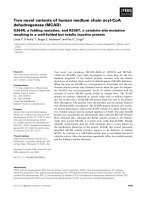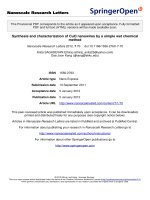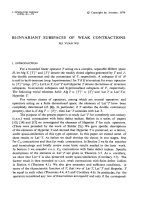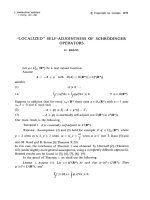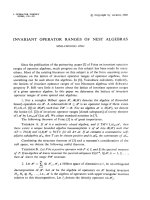Báo cáo toán học: " Two Simple Proofs of Winquist’s Identity" doc
Bạn đang xem bản rút gọn của tài liệu. Xem và tải ngay bản đầy đủ của tài liệu tại đây (69.75 KB, 6 trang )
Two Simple Proofs of Winquist’s Identity
Chutchai Nupet
Department of Mathematics
Faculty of Science, Pr ince of Songkla University
Hatyai, Songkhla 90112, Thailand
Sarachai Kongsiriwong
Department of Mathematics
Faculty of Science, P rince of Songkla University
Hatyai, Songkhla 90112, Thailand
Submitted: May 31, 2010; Accepted: Aug 12, 2010; Published: Aug 24, 2010
Mathematics S ubject Classifi cation: 11F20, 11F27
Abstract
We give two new proofs of Winquist’s identity. In the first pro of, we u se basic
properties of cube roots of unity and the Jacobi triple product identity. The latter
does not use the Jacobi triple product identity.
1 Introduction
Winquist’s identity was discovered by L. Winquist [6] in 1969. He used it to prove the
congruence
p(11n + 6) ≡ 0 (mod 11),
where p(n) is the numb er of partitions of the positive integer n. In 1972, L. Carlitz and M.
V. Subbarao [1] gave a simple proof and a generalization of Winquist’s identity. In 1987,
M. D. Hirschhorn [3] gave another generalization of Winquist’s identity. In 1997, S Y.
Kang [4] gave a simple proof using the Jacobi triple product identity, the quintuple product
identity and two other identities from Ramanujan’s notebooks. In 2003, S. Kongsiriwong
and Z G. Liu [5] gave a simple proof using t he Jacobi triple product identity and some
properties of cube roots of unity. In this paper we give two new proofs of Winquist’s
identity: for any complex number q with |q| < 1, and any nonzero complex numbers a
the electronic journal of combinatorics 17 (2010), #R116 1
and b,
∞
m=−∞
∞
n=−∞
(−1)
m+n
q
(3m
2
+3n
2
+3m+n)/2
(a
−3m
b
−3n
− a
−3m
b
3n+1
− a
−3n+1
b
−3m−1
+ a
3n+2
b
−3m−1
)
= (q; q)
2
∞
(a; q)
∞
(a
−1
q; q)
∞
(b; q)
∞
(b
−1
q; q)
∞
(ab; q)
∞
(a
−1
b
−1
q; q)
∞
(ab
−1
; q)
∞
(a
−1
bq; q)
∞
(1.1)
where (a; q)
∞
denotes
∞
n=1
(1 − aq
n−1
). In both proofs, we will use the fact about ω =
exp(2πi/3) that, for any complex number a,
(1 − a)(1 − aω)(1 − aω
2
) = 1 − a
3
. (1.2)
2 First Proof
In this section, we prove Winquist’s identity by using some properties of cube roots of
unity and the Jacobi triple product identity: for each pair of complex numbers z and q
with z = 0 and |q| < 1,
∞
n=−∞
(−1)
n
q
(n
2
−n)/2
z
n
= (q; q)
∞
(z; q)
∞
(z
−1
q; q)
∞
.
Let g(a, b) denote the right hand side of (1.1). Since h(z) := (z; q)
∞
(z
−1
q; q)
∞
is analytic
on 0 < |z| < ∞, we can write h as a Laurent series
h(z) =
∞
n=−∞
a
n
z
n
.
Since g(a, b) = (q; q)
2
∞
h(a)h(b)h(ab)h(ab
−1
), we can write g as a double Laurent series
g(a, b) =
∞
m=−∞
∞
n=−∞
c
m,n
a
m
b
n
=
∞
m=−∞
c
m
a
m
(2.1)
where c
m
=
∞
n=−∞
c
m,n
b
n
. From the definition of g, we find that g(a, b) = −a
3
g(aq, b)
and g(a, b) = −a
3
g(a
−1
, b). Thus, from (2.1), we have, for all integers m, c
m
= −q
m−3
c
m−3
and c
m
= −c
−m+3
. The first equation implies that, for each m,
c
3m
= (−1)
m
q
(3m
2
−3m)/2
c
0
,
c
3m+1
= (−1)
m
q
(3m
2
−m)/2
c
1
,
c
3m+2
= (−1)
m
q
(3m
2
+m)/2
c
2
,
the electronic journal of combinatorics 17 (2010), #R116 2
whereas the second equation implies that c
1
= −c
2
. By putting all these together, we
have
g(a, b) = c
0
∞
m=−∞
(−1)
m
q
(3m
2
−3m)/2
a
3m
+ c
1
∞
m=−∞
(−1)
m
q
(3m
2
−m)/2
a
3m+1
− c
1
∞
m=−∞
(−1)
m
q
(3m
2
+m)/2
a
3m+2
. (2.2)
By putting a = ω in (2.2), we have
g(ω, b) = c
0
∞
m=−∞
(−1)
m
q
(3m
2
−3m)/2
+ c
1
(ω − ω
2
)
∞
m=−∞
(−1)
m
q
(3m
2
−m)/2
.
Note that, by using the Jacobi triple product identity, we have
∞
m=−∞
(−1)
m
q
(3m
2
−3m)/2
= 0.
Then
g(ω, b) = c
1
(ω − ω
2
)
∞
m=−∞
(−1)
m
q
(3m
2
−m)/2
. (2.3)
From the definition of g and (1.2),
g(ω, b) = −b
−1
(ω − ω
2
)(q; q)
∞
(q
3
; q
3
)
∞
(b
3
; q
3
)
∞
(b
−3
q
3
; q
3
)
∞
. (2.4)
From (2.3), (2.4), and the Jacobi triple product identity, we obtain
c
1
= −b
−1
∞
m=−∞
(−1)
m
q
(3m
2
−3m)/2
b
3m
. (2.5)
By letting a = b in (2.2), we have
0 = g(b, b) = c
0
∞
m=−∞
(−1)
m
q
(3m
2
−3m)/2
b
3m
+ c
1
∞
m=−∞
(−1)
m
q
(3m
2
−m)/2
b
3m+1
− c
1
∞
m=−∞
(−1)
m
q
(3m
2
+m)/2
b
3m+2
.
Using (2.5), we have
c
0
=
∞
m=−∞
(−1)
m
q
(3m
2
−m)/2
b
3m
−
∞
m=−∞
(−1)
m
q
(3m
2
+m)/2
b
3m+1
. (2.6)
Substituting c
0
and c
1
in (2.2), we obtain Winquist’s identity.
the electronic journal of combinatorics 17 (2010), #R116 3
3 Second Proof
In this section, we prove Winquist’s identity with no use o f the Jacobi triple product
identity. First, we let g(a, b, q) denote the right hand side of (1.1). From the first proof,
we write
g(a, b, q) =
∞
m=−∞
∞
n=−∞
c
m,n
(q)a
m
b
n
.
From Kongsiriwong a nd Liu’s proof o f Winquist’s identity [5], we have
g(a, b, q) =
∞
m=−∞
∞
n=−∞
(−1)
m+n
q
(3m
2
−3m+3n
2
−n)/2
(1 − bq
n
)a
3m
b
3n
c
0,0
(q)
+ (−1)
m+n
q
(3m
2
−m+3n
2
−3n)/2
(1 − aq
m
)a
3m+1
b
3n−1
c
1,−1
(q)
.
Setting a = b = q
1/2
, we obtain
0 =
∞
m=−∞
∞
n=−∞
(−1)
m+n
q
(3m
2
+3n
2
+2n)/2
(1 − q
n+1/2
)c
0,0
(q)
+ (−1)
m+n
q
(3m
2
+2m+3n
2
)/2
(1 − q
m+1/2
)c
1,−1
(q)
.
It follows t hat c
0,0
(q) = −c
1,−1
(q). Thus we have
g(a, b, q) =c
0,0
(q)
∞
m=−∞
∞
n=−∞
(−1)
m+n
q
(3m
2
−3m+3n
2
−n)/2
a
3m
b
3n
− q
n
a
3m
b
3n+1
− a
3n+1
b
3m−1
+ q
n
a
3n+2
b
3m−1
. (3.1)
Next, we show that c
0,0
(q) = 1; this part of the proof is similar to Kongsiriwong and
Liu’s proof of the Jacobi triple product identity [5] and Chan’s proof of the quintuple
product identity [2]. By putting a = ω and b = −ω in (3.1), we have
g(ω, −ω, q) =c
0,0
(q)
∞
m=−∞
∞
n=−∞
(−1)
m+n
q
(3m
2
−3m+3n
2
−n)/2
(−1)
n
+ (−1)
n
q
n
ω + (−1)
m
− (−1)
m
q
n
ω
.
Since
(−1)
n
+ (−1)
n
q
n
ω + (−1)
m
− (−1)
m
q
n
ω =
2 if m and n a r e even,
−2q
n
ω if m is even and n is odd,
2q
n
ω if m is odd and n is even,
−2 if m and n a r e odd,
the electronic journal of combinatorics 17 (2010), #R116 4
we obtain
g(ω, −ω, q) = 2(1 − ω)c
0,0
(q)
∞
k=−∞
∞
l=−∞
q
6k
2
−3k+6l
2
−l
−
∞
k=−∞
∞
l=−∞
q
6k
2
−3k+6l
2
−5l+1
.
(3.2)
By the definition of g and (1.2), we have
g(ω, −ω, q) = 2(1 − ω)(q; q)
∞
(−q
3
; q
3
)
∞
(q
6
; q
6
)
∞
. (3.3)
By (3.2) and (3.3), we have
(q; q)
∞
(−q
3
; q
3
)
∞
(q
6
; q
6
)
∞
= c
0,0
(q)
∞
k=−∞
∞
l=−∞
q
6k
2
−3k+6l
2
−l
−
∞
k=−∞
∞
l=−∞
q
6k
2
−3k+6l
2
−5l+1
. (3.4)
Next, we evaluate g(−ω
2
q, −ωq, q
4
). By (3.1), we have
g(−ω
2
q, −ωq, q
4
) = (1 − ω)c
0,0
(q
4
)
∞
m=−∞
∞
n=−∞
q
6m
2
−3m+6n
2
−n
−
∞
m=−∞
∞
n=−∞
q
6m
2
−3m+6n
2
−5n+1
. (3.5)
Again, we evaluate g(−ω
2
q, −ωq, q
4
) as an infinite product:
g(−ω
2
q, −ωq, q
4
) = (q
4
; q
4
)
2
∞
(−ω
2
q; q
4
)
∞
(−ωq
3
; q
4
)
∞
(−ωq; q
4
)
∞
(−ω
2
q
3
; q
4
)
∞
(q
2
; q
4
)
∞
(q
2
; q
4
)
∞
(ω; q
4
)
∞
(ω
2
q
4
; q
4
)
∞
=
(1 − ω)(q
12
; q
12
)
∞
(q
4
; q
4
)
∞
(q
2
; q
4
)
2
∞
(−q
3
; q
12
)
∞
(−q
9
; q
12
)
∞
(−q; q
4
)
∞
(−q
3
; q
4
)
∞
=
(1 − ω)(q
12
; q
12
)
∞
(q
2
; q
2
)
∞
(q
2
; q
4
)
∞
(−q
3
; q
6
)
∞
(−q; q
2
)
∞
=
(1 − ω)(q
6
; q
6
)
∞
(−q
6
; q
6
)
∞
(q; q)
∞
(−q; q)
∞
(q
2
; q
4
)
∞
(−q
3
; q
6
)
∞
(−q; q
2
)
∞
= (1 − ω)(q
6
; q
6
)
∞
(−q
3
; q
3
)
∞
(q; q)
∞
. (3.6)
Substituting (3.6) in (3.5), we obtain
(q; q)
∞
(−q
3
; q
3
)
∞
(q
6
; q
6
)
∞
= c
0,0
(q
4
)
∞
m=−∞
∞
n=−∞
q
6m
2
−3m+6n
2
−n
−
∞
m=−∞
∞
n=−∞
q
6m
2
−3m+6n
2
−5n+1
. (3.7)
Comparing (3.4) with (3.7), we see that c
0,0
(q) = c
0,0
(q
4
). It follows that
c
0,0
(q) = c
0,0
(q
4
) = c
0,0
(q
16
) = = c
0,0
(q
4
k
) = = c
0,0
(0) = 1.
Hence we have proved Winquist’s identity.
the electronic journal of combinatorics 17 (2010), #R116 5
References
[1] L. Carlitz and M. V. Subbarao, A simple proof o f the quintuple product identity, Proc.
Amer. Math. Soc. 32(1972), 42–44 .
[2] H C. Chan, Another simple proof o f the quintuple product identity, Internat. J. Math.
Math. Sci. 15(2005), 2511–2515.
[3] M. D. Hirschhorn, A generalisation of Winquist’s identity and a conjecture of Ra-
manujan, J. Indian Math. Soc. 51(1987), 49–55.
[4] S Y. Kang, A new proof of Winquist’s identity, J. Combin. Theory 78(1997), 313–318.
[5] S. Ko ngsiriwong and Z G. Liu, Uniform proofs of q-series-product identities, Results
in Math. 44(2003), 312–339.
[6] L. Winquist, An elementary proof of p(n) ≡ 0 (mod 11), J. Combin. Theory 6(1969),
56–59.
the electronic journal of combinatorics 17 (2010), #R116 6
